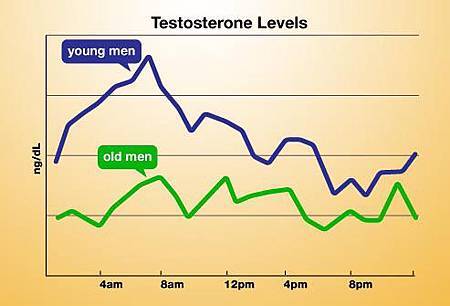[節錄]
Major Recommendations
Diagnosis/Investigation
General screening for testosterone deficiency (hypoandrogenism) in men is not recommended but should be guided by medical history and clinical examination.
Erectile dysfunction by itself is not an indication for testosterone testing. In the presence of erectile dysfunction with decreased libido and/or testicular atrophy, serum testosterone testing is indicated.
Testosterone testing is not indicated for the investigation of hypoandrogenism in women, including low libido in women.
Normal ranges for serum total testosterone and calculated bioavailable testosterone (cBAT) show method and age dependence and are determined by each laboratory independently.
Testosterone Deficiency in Males
Signs and Symptoms
In the presence of a clinical indication, serum testosterone measurement is appropriate. Hypoandrogenism is suggested by the following symptoms and signs.
Table: Signs of Hypoandrogenism in Males
|
|
|
|
|
|
|
|
|
Adapted from Bhasin et al. J Clin Endocrinol Metab. 2010;95(6):2536-2559.
Testing
Specimens should be collected in the early morning (preferably before 10 am). Testing of serum total testosterone should be done when patients are clinically stable; avoid testing during acute or subacute illness.
Serum total testosterone is the initial test of choice. If the level is below the lower limit of normal (approximately 10 nmol/L), and a diagnostic question remains, cBAT can be used to confirm hypoandrogenism.
Diagnosis
The diagnosis of hypoandrogenism is a probabilistic process based on medical history and physical findings, followed by investigational tests, guided by the clinical findings. Further investigation to determine the etiology of hypoandrogenism in men is beyond the scope of this protocol.
Monitoring of Treatment
The monitoring of testosterone therapy in men is primarily clinical. The usefulness of serum testosterone testing while on treatment is controversial.
Testosterone Excess in Females
Signs and Symptoms
A range of symptoms and signs from hypertrichosis, hirsutism, to virilization may occur.
Testing
Serum total testosterone is frequently normal in women with mild clinical hyperandrogenism (due to androgen suppression of sex hormone binding globulin [SHBG] production); cBAT testing has a better diagnostic yield for testosterone excess in women. Repeat serum testosterone testing is not indicated if cBAT is normal. A serum total testosterone level of less than 7 nmol/L will rule out almost all of the testosterone-secreting neoplasms. Other hormonal testing is dependent on clinical findings and is beyond the scope of this protocol.
Diagnosis
The diagnosis of testosterone excess is based on medical history and physical findings, followed by investigational tests. Virilization that appears over a short period of time should arouse suspicion of adrenal or ovarian tumors and urgent specialist referral is advised. Further investigation to determine the etiology of androgen excess in females is beyond the scope of this protocol.
Monitoring of Treatment
Response to treatment of hyperandrogenism in women is clinical. Therefore, testing of serum total testosterone and cBAT in patients treated for hyperandrogenism is not recommended.
Note: See the original guideline document for the following tables:
- Conditions Associated with Alterations in SHBG Concentrations
- Medications Which May Alter Testosterone Levels in Males
- Medications Which May Increase Testosterone Levels in Females
[Link to free full-text Guideline Summary at NGC online | Guideline PDF]








 留言列表
留言列表
 線上藥物查詢
線上藥物查詢 